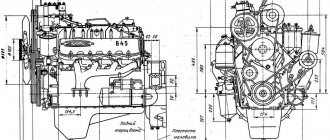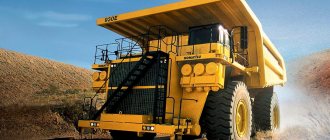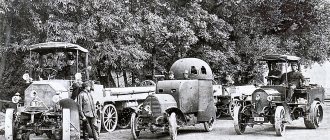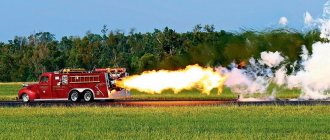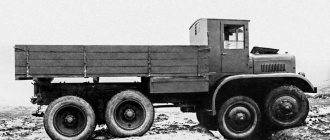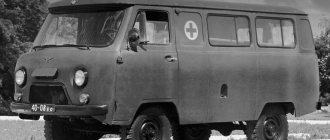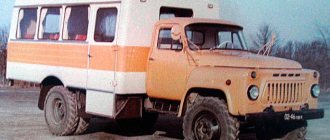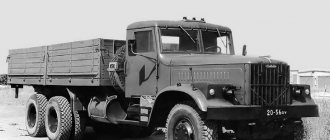Birth of a legend
In the 1960s, the Soviet Union experienced an acute shortage of trucks capable of carrying loads weighing more than 8 tons. At the same time, the development of cars of this class was already underway, but there was no production of suitable power in the country. In 1969, the government decided to build a new plant. Regions competed for the right to host the construction, because this meant a gigantic influx of funds and resources into the region for many years. As a result, Naberezhnye Chelny was chosen, at that time a small town in the Republic of Tatarstan. The choice of the city was influenced by its location in the center of the European part of the USSR, the proximity of railways and river routes. An important condition was the presence of the Nizhnekamsk hydroelectric power station, already under construction, near the city.
The enterprise has become a city-forming one. During the first five years of construction, the population of Naberezhnye Chelny grew sixfold: from 37 thousand to 231 thousand inhabitants. People from all over the Union came to the Komsomol shock construction site. In addition to the plant itself, housing, communications, infrastructure, hospitals, schools and much more were built.
It was truly a grandiose construction project. More than 2,000 contractors throughout the country carried out orders for the construction of the KAMAZ plant. 700 foreign companies provided their equipment and technologies. The enterprise's capacity was designed to produce 150 thousand trucks and 250 thousand engines per year. In 1973, the first stage of construction of the giant plant buildings was completed.
About the history of the creation of Zil-170
The terms of reference for the design of the experimental ZIL-170 implied the creation of nine modifications of heavy-duty vehicles with a 6x4 wheel arrangement for operation as part of road trains weighing up to 26.5 tons and six all-wheel drive vehicles.
This projected family of vehicles ultimately included: a three-axle truck ZIL-170, a long-wheelbase three-axle truck ZIL-170A, a short-wheelbase three-axle chassis for a ZIL-170S dump truck, a three-axle truck tractor ZIL-170T, for working with semi-trailers weighing up to twenty tons. The first of the above vehicles, in 1968, was the production of one prototype of the three-axle truck tractor ZIL-170T. The Likhachev plant produced the remaining experimental trucks the following year, 1969.
In May 1969, the first prototype of the ZIL-170 vehicle (ZIL-170T truck tractor) underwent road trials on the Uglich-Rybinsk highway section. Based on the results of the run, we concluded that the 180-horsepower power of the Yaroslavl diesel engine YaMZ-6E641 is not enough for a car of this class. Installing an eight-cylinder 240-horsepower YaMZ-238 would have enlarged the engine compartment and would have required a complete redesign of the cabin. But then the YaMZ-740 (aka the future KamAZ-740) was developed in Yaroslavl, and everything fell into place.
“Take, Motherland, the first KAMAZ!”
With this slogan on board, the first production truck under the Kama Automobile Plant brand with model number 5320 rolled off the assembly line on February 16, 1976. There was a counter in the city that counted down the time until the release of KAMAZ. It was a real holiday for Naberezhnye Chelny and for the whole country. Today that first car is kept in the plant museum.
KAMAZ-5320 was produced with minimal changes until 2001, and it can still be found on the roads of Russia and neighboring countries. The KAMAZ-5320 cabin may seem spartan today, but then it was considered one of the most comfortable and safest in its class. Unpretentiousness in maintenance and affordable repairs have become the hallmark of KAMAZ. By the end of the 80s, the country was covered by a network of branded auto centers that carried out maintenance and supplied spare parts for trucks.
A little more than ten years after the production of the first car, the company celebrated its anniversary in 1988 - the production of the millionth truck. According to experts, in the first ten years of operation, KAMAZ fully justified all the funds invested in it.
Also in 1988, the KAMAZ-master racing team was created at the plant, which took on the mission of testing the reliability of trucks at international off-road rallies. Since then, the team's crews driving modernized KAMAZ trucks have become winners of the world's most prestigious rally, the Dakar, 16 times, and have also won the World Cup of Off-Road Rallies three times.
Despite the difficult situation in the 90s, when factories of the former USSR were closed one after another, KAMAZ remained in service and produced new models of trucks. In the 2000s, the company reached the global level and created joint productions with partners from the USA, Germany, India and other countries. Equipment exports in 2007 reached their maximum value at that time - 13,444 units per year.
KAMAZ - the history of the formation of a major Russian automaker
KAMAZ is a domestic manufacturer of trucks and power units, operating since 1976. The company is engaged in the production of: buses, electric buses, water buses, tractors, combine harvesters, power plants and components for them. The main production site is located in Naberezhnye Chelny. The main goal of creating a new plant was to restore the economy of the USSR, which was in dire need of trucks. It was necessary to master the assembly of cars with a carrying capacity of 8 - 20 tons and equip them with diesel engines. Enterprises that existed in the 1960s could not meet this need in the required volume.
Photo: CAR.RU
In 1969, it was decided to begin construction of a plant in the Tatar Republic. For this purpose, an almost ideal location was chosen, which provided open access to major roads and railway lines. According to the original plan, the plant was supposed to produce up to 150,000 cars annually.
Construction work began in December of the same year. After 2 years, we managed to rebuild the first buildings on the site. The total area of the territory exceeded 3000 sq.m. The finished workshops were quickly equipped with the equipment necessary for the production of vehicles. Already at that time, most of the systems were automated for ease of assembly of components. It is known that equipment for the production site was supplied from European countries and the USA. To attract employees, they began to build the first houses for their residence.
The carrying capacity of the finished equipment was 10 – 20 tons, depending on the modification
Construction was completed in 1975. A year earlier, the first power unit running on diesel fuel was assembled at the experimental site. The first car left the workshop in February 1976. We are talking about the KamAZ-5320 - a three-axle truck that was built on the basis of the ZIL-170. The carrying capacity of the finished equipment was 10 – 20 tons, depending on the modification. The equipment included a power unit with a power of 210 hp, which could accelerate the car to a maximum of 90 km/h. The first built copy has been preserved and is now in the brand museum.
Huge profits were noted in the 1980s. In just 10 years of work, we managed to recoup all the expenses that went into building the plant.
At the end of 1976, an order was issued to organize the serial assembly of vehicles. It was planned to build 15,000 units of equipment in a year, but the company managed to cope with the order ahead of schedule. As a result, the plan was exceeded by 7,000 units.
In the summer of 1979, 100,000 trucks were assembled on the assembly line - this was a record. In 1987, the company launched production of the VAZ-1111 Oka model. This model was produced until 1994.
Huge profits were noted in the 1980s. In just 10 years of work, we managed to recoup all the expenses that went into building the plant. KamAZ vehicles were in demand, as they transported most of the cargo throughout the country. The number of people living in the plant's residential complex grew to 400,000. In 1983, an unpleasant event occurred - a fire that engulfed almost the entire territory. Despite the damage, the plant began operations the following year.
The main share in production is occupied by tractors and dump trucks
Nowadays, KamAZ produces various equipment. In 2010, in partnership with FIAT, the assembly of road equipment began. Over the course of a year, it was possible to assemble more than 3,000 tractors and agricultural machines. In 2011, 45,000 units were built. The main share of production is occupied by tractors and dump trucks.
Bottom line. KAMAZ is a domestic enterprise that was founded in the 1960s. The brand’s equipment was in demand in the USSR and continues to be sold in modern Russia.
Not just trucks
KAMAZ is known not only for producing trucks under its own brand. Since 2000, the Neftekamsk Automobile Plant, a subsidiary of KAMAZ, has been producing NEFAZ city buses, which today can be seen in many Russian cities.
Currently, KAMAZ produces electric buses developed jointly with Russian engineers from Drive Electro. Electric buses are superior to traditional public transport in terms of noise, environmental friendliness and efficiency. Today, 30 electric buses produced by KAMAZ are running around Moscow, and new eco-friendly vehicles and charging stations are expected to be delivered in the near future.
Another promising project that began testing in 2015 is the development of an unmanned vehicle. Already in 2016, KAMAZ, together with the NAMI scientific institute, presented the concept of the Shuttle project, small unmanned buses for the city. The first drones within the project were tested in limited areas: universities, science cities, and exhibition complexes. Meanwhile, the government is working on regulating driverless vehicle legislation.
KAMAZ is a great child of stagnation
Many are sure that this was possible only in the USSR - in just six years, practically from scratch, a giant of the automotive industry was created. Even the US Congress recognized that it was impossible to solve such a problem using market methods. Indeed, it is impossible, but the example of the Soviet Union is not the only one here. Approximately the same mobilization methods, with the active participation of the state, created the largest Japanese and Korean corporations - Mitsubishi, Mitsui, Daewoo, etc. Many of them are still alive today, but now as private transnational companies.
By the time the CPSU Central Committee decided to build an automobile plant, Naberezhnye Chelny was a provincial town with 27 thousand inhabitants and a minimum of industry. But the town was very well located - in the very center of the country at the intersection of two waterways - the Kama and the Volga, near large railways, which made it possible to provide the future plant with the necessary building materials, raw materials and components.
The construction of KAMAZ was essentially a repetition of the history of Soviet industrialization, only without excesses and repressions. State capital, mobilization of labor (the city's population grew by 30-40 thousand people per year), the use of advanced foreign experience. As a result, the USSR received a plant capable of producing tens of thousands of cars per year.
What does America have to do with it?
The Americans then had a reason to gloat: the Soviet plant was built by the USA! Not certainly in that way. More than 700 foreign companies, European, American, Canadian and Japanese, participated in equipping KAMAZ. And another 2 thousand Soviet enterprises. By the way, this is a good illustration of the scale of the project; for comparison, 3 thousand enterprises participated in the project to create the Soviet shuttle Buran. Another interesting point: to attract Western companies, the USSR used loans received in the USA. This is how the sharks of capitalism once again took part in a grandiose socialist construction project.
All the grandiose projects of the USSR quickly became overgrown with all sorts of myths. For example, supposedly in the 1970s the USSR needed large-diameter pipes not for gas and oil pipelines, but for the production of missiles; the gas pipeline itself to Europe was built in order to provide fuel for armadas of Soviet tanks in the event of war. So KAMAZ, if rumors are to be believed, can switch from producing trucks to producing tanks in just three months.
Life after death
K5 is the most anticipated new product of the year
For its 50th anniversary, KAMAZ is preparing a unique gift - the launch into mass production of the first KAMAZ-54901 tractor from the new K5 family. The K5 generation cars mark the company's entry into the premium segment. The first pre-production tractor is already being run-in and tested.
The new model features improved ergonomics, modern components and assemblies. Particular attention is paid to the cabin, which is made to all the latest standards of safety and comfort. The K5 family will be equipped with an inline 6-cylinder P6 engine with power ranging from 380 to 550 hp. and a resource of 1.5 million km, which corresponds to the best world analogues of this class.
Modernization of production, creation of a new model range, entry into world markets - all this would be impossible without investment. In 2022, as part of a joint investment project, the Rostec State Corporation allocated 5.5 billion rubles to KAMAZ.
KAMAZ is approaching its half-century anniversary as the largest Russian manufacturer of heavy trucks, which corresponds to all modern trends. This includes the digitalization of production, the development of eco-transport, and the development of drones. KAMAZ is regaining its status as a city-forming enterprise, increasingly influencing the social sphere of Naberezhnye Chelny. The changes in recent years at KAMAZ have laid a powerful basis for the further successful development of the enterprise.
Features of the ZIL-170 truck
The ZIL-170 car was significantly different from trucks with diesel engines already produced in the Soviet Union (meaning the KrAZ trucks of the Kremenchug and MAZ trucks of the Minsk automobile plant). It differed both in design and in the layout of the main components and assemblies.
- New diesel V-shaped power unit;
- original clutch - double-disc with an intermediate plate, with pneumatic hydraulic booster and remote control,
- five-speed synchronized gearbox with a front divider, which turned it into a ten-speed,
- separate drive of pneumatic brakes on the front and rear axles,
- driving rear and middle axles with a center differential lock,
- steering with modern hydraulic booster,
- improved springs,
- cardan transmission designed to increase service life,
- reaction rods with innovative complex sealing,
- discless, spoked wheels with new model tires,
- new all-metal cargo platform,
- spacious, convenient and comfortable (at that time) cabin, with the possibility of creating a full-fledged berth,
- Opportunity to work as part of a road train.
These were the features of a qualitatively new truck, which made it possible to take a huge step forward in the production of Soviet mass-produced trucks.
In general, for the first time in the history of the domestic automotive industry, a divider was used on a truck in a gearbox, increasing the number of stages from five to ten.
There were other original technical solutions. For example, “overlay” cabin doors that do not fit flush into the doorway. This made the production of stamped parts cheaper. The “flange type” doors were joined to the cabin with an overlap, which made it possible to worry less about the gaps between the door and the cabin and ensured that the cabin was airtight.
The 6×4 wheel arrangement for the new truck was not chosen by chance. The continuous increase in the carrying capacity of serial vehicles (for example, the carrying capacity of the ZIL-130 increased over time from four to six tons) led to the same constant increase in the load on the axles of cars. This had a negative impact on the condition of the already imperfect Soviet roads. And for the promising ZIL-170 truck with a load capacity of 8 tons, the calculated axle load did not exceed six tons. It was decided to reduce the load on the road surface by making the car three-axle.
